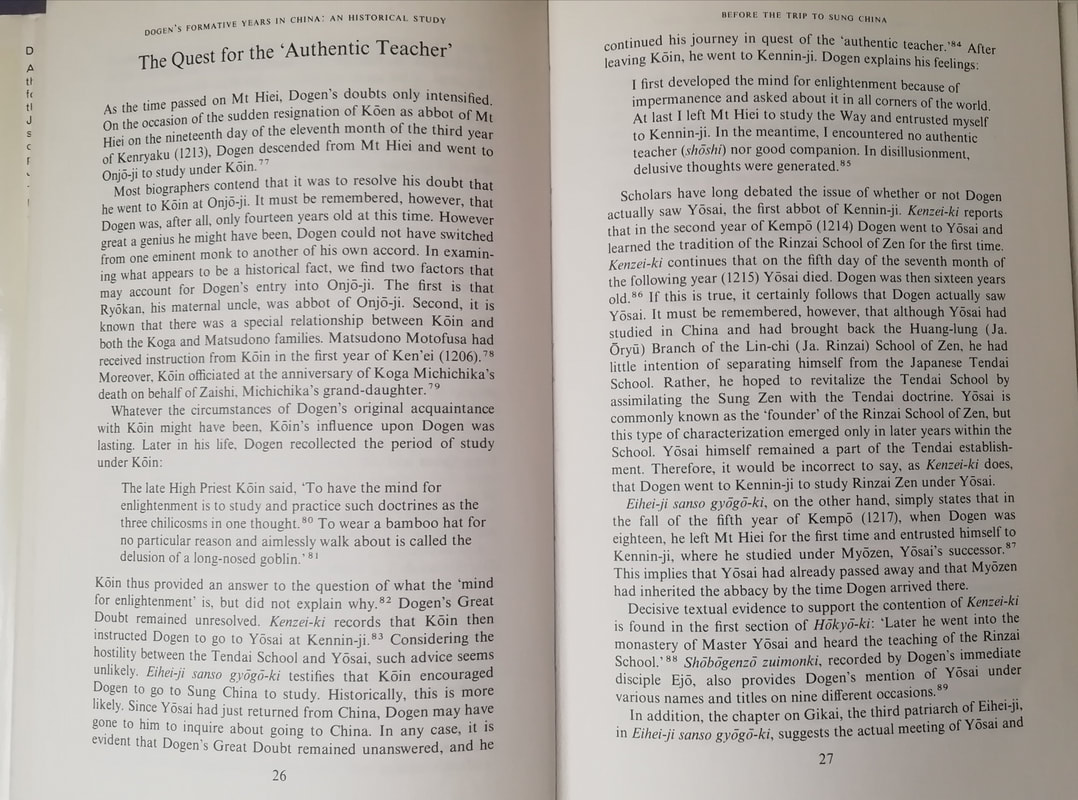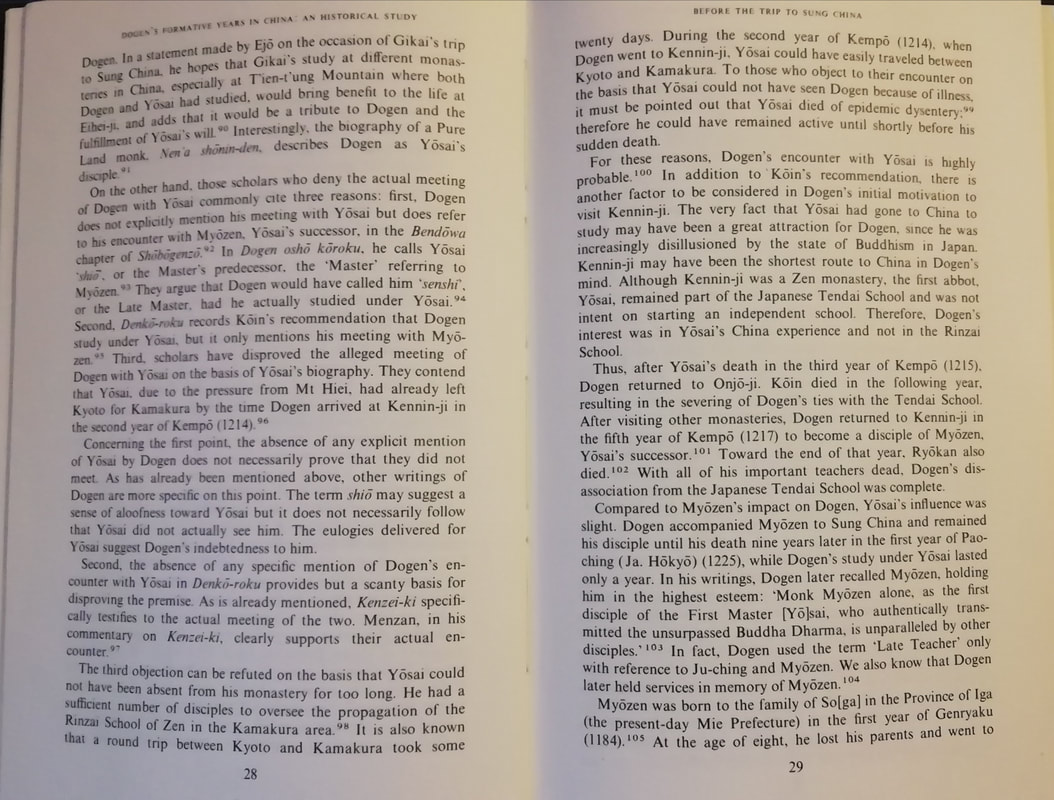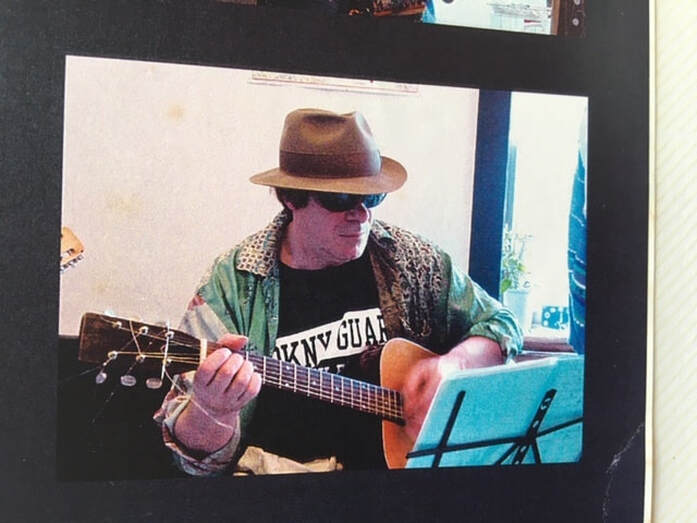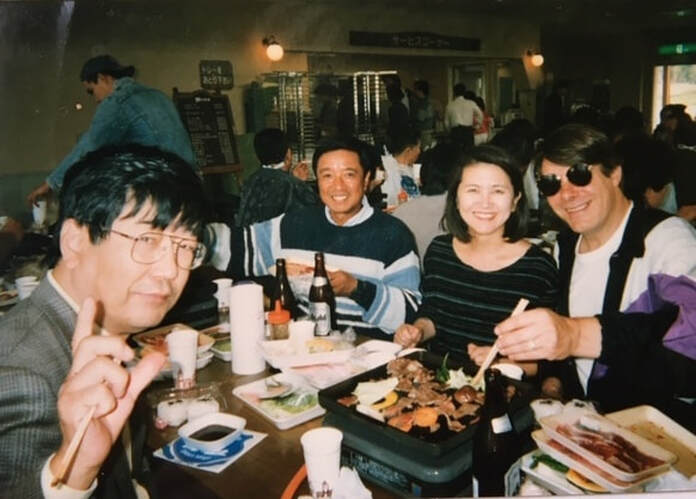|
Richard Hunn (1949-2006) passed away 17-years ago (as of October 1st, 2023). He was just 57-years old - having suffered from a short but devastating illness (Pancreatic Cancer). As with any good Ch'an Master - Rixhard Hunn tended to refuse any formal titles or awards - as he felt such baubles weighed-down a practitioner diverting the awareness away from the 'host' and toward the 'guest'! Besides, Charles Luk bestowed upon him the Dharma-Name of 'Wen Shu' - the name of the Bodhisattva Manjushri who appears all the way throughout the Buddhist Sutras - spreading his 'wisdom' and 'compassion' to all and sundry! After emigrating to Japan in 1991, Richard Hunn decided to carry-out a pilgrimage to Mount Fuji! For reasons only known to himself - this journey was carried-out in the depths of Winter - when the wind blew and the snow fell! When things were looking bleak - a person appeared out of nowhere and helped Richard Hunn seek-out assistance! A passing Senior Police Officer decided to take Richard into Custody whilst he investigated his background and motives. He was surprised when Richard started to converse with him in the Japanese language. When the Officer had sat and discussed Zen for an hour in a comfortable Police Station (whilst Richard was given a warm meal and drink) - The Officer ordered that Richard be driven to the peak of Mount Fuji and given a hotel room usually reserved for the Police! This was apparently out of respect for Richard's understanding of Zen - and his mastery of the Japanese language! Interestingly, around 2002 Richard visited my family home in Sutton (South London). I eventually introduced him to my Hakka Chinese grandmother - and to my astonishment he started talking to her in the Hakka language! She was taken by as much surprise as was I! Apparently, he had known a number of Hakka Chinese people at Essex University (I believe from Malaysia) who were members of the University's Chinese Buddhist Association. This ethnic Chinese group actually voted Richard to be the 'President' - the only non-Chinese person to have held that post up to that point! I believe this was during the late 1970s - when he also participated in the Multicultural Department of BBC's Pebble Mill (a general education and entertainment programme). Richard often arranged for British Buddhist content to be filmed and broadcast. He was personally responsible for a documentary covering the Thai Buddhist Temple (Buddhapadipa) situated in Wimbledon! Richard Hunn had spent an extended time sat meditating in that temple - with the Thai Head Monk suggesting that he became a Theravada Buddhist monastic! I watched this programme as a child - and only many years later would I meet Richard Hunn - and eventually take my place in the Meditation Hall of Buddhapadipa! Charles Luk had said that the empty mind ground underlies ALL circumstances an that it does not matter where we train just as long as we effectively 'look within' with a proper intensity and direction! Whilst Richard Hunn was establishing himself in Japan - he suggested that I travel to a Theravada country and train 'at the source', so-to-speak. This is how I ended-up training under Mangala Thero (in 1996) at the Ganga Ramaya Temple (in Beruwela) - situated in Sri Lanka. I have subsequently discovered that Mangala Mahathero has passed away after spending the last decade of his life living and meditating in isolation. I am told that Richard Hunn would sit 'still' for hours on end in various Zen Temples throughout the Kyoto area. Although outwardly he was practicing 'Zen' - inwardly he was practicing 'Caodong' Ch'an - the preferred lineage of Master Xu Yun (1840-1959). Although none of us know how long we will be on this Earth - we must remain vigilant and use our time effectively and productively! Not a single second must be wasted when it comes to self-cultivation! Instead of reading this board - look within! At this time of year I usually contact Richard's widow - Taeko - and offer my respects!
0 Comments
Remembering Richard Hunn (1949-2006) - Sixteenth Commemoration of His Passing! (1.10.2022)10/5/2022 At certain times it seems more appropriate to remember particular events - whilst at others it is more in keeping (and more opportune) to just let certain dates and times to quietly go by without making any comment. Ch'an certainly has no interest in the conventions of the world - and Ch'an Masters even less! Bodies come into existence and then pass-away - utilising various time-frames inbetween. Society 'measures' these time-spans for scientific reasons - but all the Ch'an Method is concerned about is that each individual 'realises' the empty mind ground! Remembering the physical existence - and the 'joy' Richard Hunn's presence in the world symbolised - the Ch'an Method insists that we 'remember' to 'look' within so that we can directly perceive the 'empty mind ground' with clarity and without interruption! Richard Hunn lived for fifty-seven years and every one of those years emerged from (and eventually returned to) the empty mind ground. This image above, for instance, is a bridge situated in the remote and surrounding (mountainous) areas outside of the City of Kyoto - the place he lived within from 1991-2006. Richard Hunn was engaged in studying the origins of Chinese Ch'an in Japan - and whilst doing this he visited many and numerous Zen Temples and was introduced to 'old' ethnic Japanese martial arts teachers who lived in seclusion whilst practicing 'Chinese' martial arts systems 'outside' of the official grading system of 'coloured belts' authorised by the Japanese Government (usually possessing only a single disciple whose family possessed the financial means to support this sibling and his or her Master). Such Japanese teachers have to live in a remote and simplistic poverty as a form of 'punishment' - as such individuals are not entitled to the generous financial, material and political support afforded to the so-called 'Japanese' martial arts systems 'preferred' by the Japanese Establishment! The point is that Richard Hunn studied a broad segment of Japanese culture - making his living teaching the English language and English literature at Kyoto University. He travelled widely throughout Japan - lived in an old Samurai Cottage - and made effective attempts to see 'through' the preferences and bias of modern Japanese culture - seeing the Chinese roots of much of Japanese culture that is now denied, ridiculed or even actively negated in Japan! In the material realms of study, science and academia all this data collecting is of vital research importance - but none of it transcends the need for the Ch'an Method and the need to effectively 'look' within! This is why I remember the two sides of Richard Hunn - the academic who traversed the material environment making important notes and observations - and the Ch'an Master who effectively 'looked' within, whilst helping others to do the same!
I apprenticed with Richard Hunn (1949-2006) for sixteen years - and it was from his expert guidance that I learned to read traditional and simplified Chinese script! As for the ethnic Chinese side of my family - I learned an old form of the Hakka language mixed with Hong Kong Cantonese - but I did not learn Chinese ideograms (other than a handful marking key Chinese philosophical terms). I mostly learned the 'pinyin' of Mainland China as this overlapped with my Western (British) education! Richard Hunn was not only a leading British Sinologist who had been accepted within the ethnic Chinese community - he had also studied with (and inherited) a legitimate Ch'an lineage under an ethnic Chinese teacher - Charles Luk (1898-1978)! In 1991, Richard Hunn took the decision to permanently relocate to Kyoto, Japan, to embark upon a commisioned study programme designed to research the Chinese Ch'an Buddhist roots of Zen Buddhism in Japan! Kyoto is an ancient city that was spared Allied blanket-bombing during WWII and still possessed ancient 'Chinese' Ch'an temples tucked between typical Japanese Zen Buddhist temples, whilst in the remote hills surrounding Kyoto, there still existed Japanese martial arts Masters who lived in rustic huts (usually with a single disciple), who practiced, preserved and passed on Chinese martial traditions that did not receive the usual Japanese government financial, cultural or political support due to their refusal to adopt the coloured-belt system of Judo - and make an official proclamation denouncing their 'Chinese' heritage. These old Masters usually survived through the kindness of rich patrons. Richard Hunn, however, was permitted a number of interviews with some of these Masters who described the history of the martial and medicinal lineages they upheld! All this stems from the fact the Japanese convention is to 'separate' lineages - whilst the Chinese tendency is to 'integrate'! In Japan, 'Soto' and 'Rinzai' are presented as unrelated Buddhist traditions - whilst in China - 'Caodong' (Soto) Masters readily resorted to all kinds of methods to free the minds of their students (including the hua tou and gongan), whilst a number of Linji (Rinzai) Masters allowed their disciples to 'sit quietly' and contemplate the empty essence of their minds! Part of this issue can be traced to the dynamics of the transmission process. Zen Master Dogen [道元 - Dao Yuan] (1200-1253), for instance, was an 'enlightened' Rinzai Master before he set-off to Japan during 1223! (His name literally translates as 'Way Origin' - or 'Emergence of Perfect Order' - and is probably related to the Confucian concept of 'Li' [禮]. That which is good but 'invisible' - through correct thought and virtuous action - is made 'visible'). When he arrived, he found his understanding was deficient (even amongst the Linji Sects), and was completely exposed when communicating with the Caodong Masters! What is presented below are a few pages of the book entitled 'Dogen's Formative Years in China - An Historical Study and Annotated Translation of the Hokyo-Ki' By Takashi James Kodera, Routledge, 1980, Pages 26-35. None of the above or following scholarship is included in this book. However, as it is my function is to facilitate the further transmission of authentic Chinese Ch'an into the West - this extra data is provided to empower the general reader to a greater degree, so that they may possess a deeper appreciation of the subject matter at hand from a Chinese language perspective, given that Takashi James Kodera has done such a good job at presenting the Japanese cultural perspective. The term pronounced 'Hokyo-Ki' in the Japanese language is written using the following Chinese ideograms:
a) 宝 (Bao) = Ho - Precious, Treasure and Cherish b) 庆 (Qing) = Kyo Virtue, Auspicious and Congratulate c) 记' (Ji) = Ki Record, Chronical and Notes Therefore, Hokyo-Ji = Baoqing-Ji (宝庆记)! Dogen studied in China between 1223-1227 CE - which was the time of the Southern Song Dynasty (1127-1279 CE). Emperor 'Lizong' (理宗) reigned between 1224-1264 CE. Dogen named this book after the first 'Era' of Lizong's reign which was termed 'Baoqing' (宝庆) - named after a house the emperor particularly favoured (a house of 'Cherished Virtue'). The ''Baoqing' (宝庆) Era measured three years of chronological time: 1) 1225 - Stem and Branch 'Yiyou' (乙酉) 2) 1226 - Stem and Branch 'Bingxu' (丙戌 3) 1227 - Stem and Branch 'Dinghai' (丁亥) Dogen's text then, purports to record in writing the details of the experiences he encountered whilst traversing the Zhejiang area of East China, and the information he gathered for the years '1225'. '1226' and ''1227'. This is a significant observation as this book omits the first years of '1223' and '1224' of Dogen's visit to China and instead focuses upon his interaction with the Caodong Ch'an teacher - Master 'Tiantong Rujing' (1163-1228). Therefore, the Baoqing Record (宝庆记) is a manual of all the dialogues and interactions that occurred between Dogen and Master Rujing! It is the fruit of this communication through which Dogen attained to a genuine understanding of the empty essence of his mind! This is a remarkable outcome considering that when he first made port in Zhejiang - the Chinese Authorities required that he stay on his ship for three months whilst a question regarding his Buddhist Ordination was clarified (as his Entry Visa was dependent upon his credentials as a fully Ordained Buddhist monastic). Although he had taken the Bodhisattva Vows - he had not yet taken the Vinaya Discipline Vows - a situation which was eventually rectified and he was granted entry! Richard Hunn (1949-2006) lived in Kyoto, Japan, from 1991 until his passing in 2006 (aged 57). He taught English Literature and English Language at Kyoto University and its environs. He chose Kyoto due to its hallowed antiquity and to study at its many (ancient) Zen Buddhis Temples. Indeed, many such temples in this area still upheld the Chinese Ch'an tradition with others practicing archaic Chinese martial arts. In many ways, this activity happened within a cultural bubble due to the strength of the surrounding (indigenous) Japanese culture. Indeed, Richard met a number of very advanced Japanese Masters who were permanently 'excluded' from ALL Japanese institutions and funding bodies as a 'punishment' for choosing to dedicate their lives to the studying of 'Chinese' cultural arts (unsullied by Japanese influence). The stories of this are many and varied, with this 'exclusion' even applied to Japanese Masters who still practiced 'Old' styles of Japanese swordsmanship that did not conform to the strictures of modern Kendo! After reading Brian Victoria's book entitled 'Zen At War' - Richard Hunn explained to me that Chinese Ch'an (outside of China) - as a distinct spiritual path - is being systematically obliterated by the aggressive policies demanded by the Japanese government. This is why Richard Hunn originally named the simple 'Ch'an Forum' we established in 2004 the 'Chinese Ch'an Buddhism Association' - a title I fully endorsed. This existed between 2004-2006. However, out of respect for my teacher I took the decision to re-name his project the 'Richard Hunn Association for Ch'an Study' in late 2006. This coincided with me developing closer ties with Mainland China and receiving encouragement to continues Richard work. Although my work has been published in The Middle Way, I am not a supporter of The Buddhist Society due to its historical anti-China attitudes and the fact that a Mainland Chinese friend of mine was discriminated against when visiting The Buddhist Society in London.
This photograph of Richard Hunn as a young teenager was forwarded to me by his widow - Taeko Hunn (nee 'Watani') - who continues to live in Kyoto, Japan.
With Metta Shuffling off the mortal coil, within the context of Chinese Ch’an Buddhist practice, is often associated with the male or female practitioner leaving the body whilst sat in the cross-legged, upright meditation position. Breathing slowly reduces until it can no longer be discerned, and the bodily processes come to a gentle halt. Chinese Ch’an literature is replete with recorded stories of men, women and children dying whilst standing, sitting or lying down, whilst retaining a particular posture. Some enlightened peasants have also passed away at a whim whilst working in the fields without a moment’s hesitation. Such an activity is inherently associated with the attainment of enlightenment and is still fairly common, even within Mainland China today. This is known as the practice of ‘Seated Transformation’ (坐化 - Zuo Hua), and is common in both advanced Buddhist and Daoist practice. By the time Richard Hunn passed away on October 1st, 2006, his body had been substantially weakened through months of spreading cancer and the effects of various radiation treatments – but he stated to me that he was going to die whilst ‘sitting up’, and that was that. As matters transpired, Richard Hunn passed away whilst sat-up in a Kyoto-hospital bed – and as his life-processes dissipated, he asked to go to the bookshop and buy some Wordsworth... I have researched both ancient and modern cases of ‘Zuo Hua’ in China and studied the photographs and eye-witness reports. The 6th Patriarch of Ch’an - ‘Hui Neng’ (坐化) - died in 713 CE and his body still sits upright in meditation, as does the body of Master Han Shan (憨山) who died in 1623 CE. There are many more – Daoist and Buddhist – scattered throughout the temples of China, and added to this are the hundreds and thousands of other ‘ordinary’ people who passed away sat-upright in-front of witlessness (often with written and photographic evidence). In my own seated practice, I understand that although the spine can be kept ‘buoyant’ whilst still consciously aware, the head inevitably drops forward when the sleep process is triggered, or the death process manifests. Many modern seated deaths end with the upper-body leaning (naturally) forward as the muscles completely relax. I am told that the alignment of the bones is the answer – (as in the advanced practice of Taijiquan). If the bones are aligned properly whilst seated, then the posture (I.e. ‘bones’) will be self-sustaining when all muscle-tension and control dissipates at the point of death. Elongating the vertebrae of the neck whilst pulling the chin slightly in should prevent the head from drooping at the point of death. Should my partner – Gee – be present when I experience ‘Zuo Hua’, I have requested that she photograph and film the experience for the progression of scientific understanding.
|
Archives
March 2024
Categories
All
|


























 RSS Feed
RSS Feed